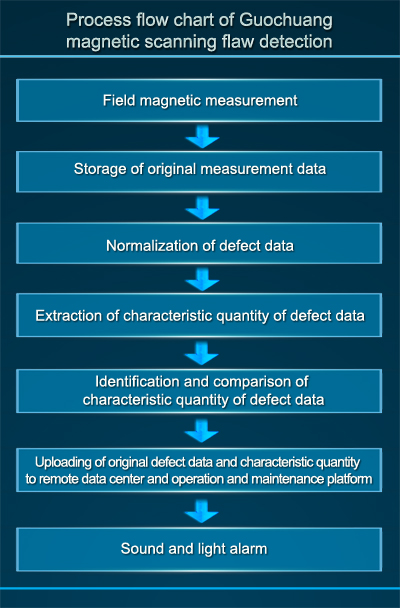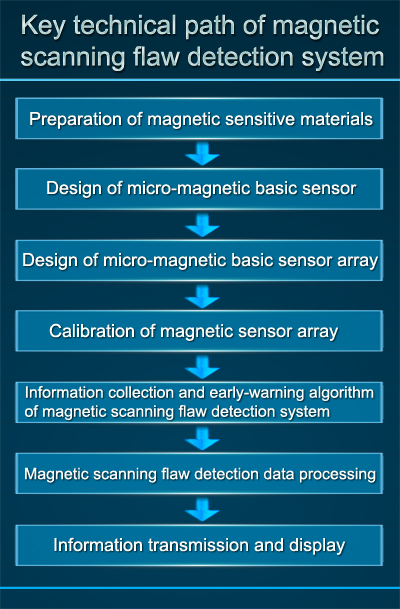![]() Background analysis:
Background analysis:
In social construction, steel structural parts are ubiquitous, such as steel rails, train axles, train wheels, steel cables (elevator cranes, conveyor belts, suspension bridges, etc.), steel pipes, deformed steel structural parts (aircraft landing gear, etc.), buildings steel frame, etc. Long-term use of them under high load conditions will cause cracks, wear and tear, deformation and rust. For example, steel rails will wear, crack, twist, and even break during use, which will seriously threaten the safe operation of railways; long-term use of pipelines will inevitably lead to pipeline leaks due to corrosion and rust. For dangerous objects such as petroleum and liquefied natural gas, such as flammable and explosive, they will deflagrate in severe cases, causing casualties and property losses. In addition, for deformed steel structural parts, such as aircraft landing gear, it will cause damage to the aircraft during landing in case of any damage. For steel structural parts used in buildings, if cutting corners or using inferior steel, it will lead to collapse accidents in the worst-case scenario. For example, the Hong Kong railway track crack in 2019 caused one train to derail and hit another train, resulting in a major accident in which eight people were injured. The wear and tear of steel cable may result in fracture accidents in severe cases. In a hoisting accident on Desheng East Road, Zhejiang, the steel wire rope of one of the cranes suddenly broke when the box girder was removed from the flyover, causing the cut beam to be removed from the support and the steel pipe support to collapse, and resulting in a major accident with 1 death and 3 injuries . Therefore, it is necessary to conduct flaw detection monitoring on the damage of common steel rails, steel cables, steel pipes or deformed steel structural parts, and building steel structure parts, with NDT being especially urgent.
Flaw detection of steel structural components is a process to detect whether there are defects in steel and welds. It is a means to ensure the material and welding quality of steel components. There are many NDT techniques for flaw detection. The conventional testing methods are as follows: ultrasonic testing, eddy current testing, magnetic particle testing, penetration testing, radiation testing, magnetic flux leakage testing and other technologies. The shortcomings of ultrasonic testing include: smooth working surface, experienced inspectors to distinguish the types of defects, no intuitiveness for defects, and suitable for inspection of thicker parts. Eddy current testing can be used for metal material flaw detection. As high-frequency excitation signals must be used, it is easy to cause signal interference and create complicated signal processing, and the depth of detectable defects of eddy current flaw detection is limited. Magnetic particle testing can only be used to detect the defects on the surface and near surface of ferromagnetic materials, usually with a shallow detectable depth; magnetic suspension may cause environmental pollution; it applies to the detection of defects on the surface and near surface, rather than on-site testing. Penetration testing can only be used for testing of nick on the surface of dense materials, which has higher requirements on the tested surface; penetration testing has higher requirements on the operation skills of the operators; it will cause environmental pollution and is suitable for testing of nick on the surface. Radiation detection has environmental radioactive pollution that threatens human health, and has long testing period, low efficiency and poor instantaneity. The metal magnetic memory detection technology is a rapid NDT method that uses the metal magnetic memory effect to detect the stress concentration of components. It overcomes the shortcomings of traditional non-destructive testing in that it can detect ferromagnetic metal components (such as steel rails, steel cables, steel pipes, aircraft undercarriage, deformed steel structural parts, structural steel structure, etc.) internal stress concentration areas, that is, microscopic defects and failures and damages in the early stage, etc. are determined to prevent sudden fatigue damage. It is a new testing method in the field of non-destructive testing.
![]() Principle:
Principle:
Magnetic memory flaw detection belongs to the field of NDT. It is one of many physical flaw detection methods such as X-ray, ultrasonic, magnetic powder, eddy current, γ-ray, penetration (fluorescence, coloring), magnetic memory, magnetic flux leakage, etc. It is a rapid NDT testing method using metal magnetic memory effect to detect the component stress concentration.
The so-called metal magnetic memory effect refers to: when ferromagnetic metal parts are in processing and operation, due to the combined action of the load and the geomagnetic field, the magnetic domain organization orientation and irreversible reorientation with magnetostrictive properties will occur in the stress and deformation concentrated areas. This irreversible change of magnetic state will not only remain after the working load is removed, but also be related to the maximum applied stress. This magnetic state on the surface of the metal member "memorizes" the location of the microscopic defect or stress concentration, which is the so-called magnetic memory effect. When the ferromagnetic component in the geomagnetic field is subject to external load, the magnetic domain organization orientation and irreversible reorientation with magnetostrictive properties will occur in the stress concentration area, and the fixed node of the magnetic domain will appear in this part, resulting in magnetic poles and forming a demagnetizing field, so that the magnetic permeability of the ferromagnetic metal in this part will be minimized, and a leakage magnetic field will be formed on the metal surface. The tangential component Hpx of the leakage magnetic field strength has a maximum value, while the normal component Hpy changes sign and has a zero value. This irreversible change in the magnetic state remains in memory after the work load is removed.
The principle of metal magnetic memory is shown in the following figure. A testing instrument based on the basic principle of the metal magnetic memory effect records the distribution of the magnetic field intensity component perpendicular to the surface of the metal member in a certain direction, and can evaluate the stress concentration of the member and whether there are microscopic defects. It can diagnose the area with internal stress concentration of ferromagnetic metal components, namely the microscopic defect and early failure and damage, for preventing the sudden fatigue damage, which is a new testing method in the field of NDT.

![]() Functions:
Functions:
Guochuang Magnetic Scanning Flaw Detection System uses the metal magnetic memory effect to detect stress concentration locations such as steel rails, steel cables, steel pipes, aircraft landing gears, deformed steel structural parts, and building steel structures (i.e. microscopic defects, fast NDT method of early defects and damage, conduct real-time online non-destructive magnetic anomaly detection of ferromagnetic material components such as steel rails, steel cables, and steel pipes, and digital filtering and statistical analysis of measurement data in time domain, frequency domain and space; with the help of feature recognition algorithms, it not only can determine the existing internal defects (such as cracks, slag inclusions, abrasion, nuclear damage and other materials, processing and welding defects) and their positions and shapes of rails, steel cables, steel pipes, etc., but also predict the formation and development of defects through the change trend of internal stress over time.
Among them, Guochuang Magnetic Scanning Flaw Detector used for steel cables such as elevator cranes, conveyor belts, suspension bridges, and suspension cables can be made into three categories: static, self-propelled, and hand-held, and it can detect the abnormal magnetic change of one broken steel wires among 100 of them; it can be used in railways such as steel rails, train wheels, train axles, special inspection devices, usually hand-held, fixed and self-propelled; used for special-shaped structural parts such as aircraft landing gear and other irregular steel structures. There are mainly two types of special detection devices for flaw detection: mobile or fixed. Magnetic scanning flaw detector used for steel pipes is also divided into three categories: handheld, fixed and self-propelled.
![]() Technical solution:
Technical solution:
The magnetic scanning flaw detection system is mainly composed of Guochuang Magnetic Scanning Flaw Detector, data communication system, data processing system, sound and light alarm system, etc., which can be used for real-time online detection of damage and early warning of stress concentration parts such as steel rails, steel cables, steel pipes, aircraft landing gears, and building steel structures.


![]() The main components of the system:
The main components of the system:
1. Guochuang Geomagnetic Scanning Flaw Detection System is composed of micro-magnetic basic sensor array, communication module, digital signal unit, etc.;
2. The micro-magnetic basic sensor array is installed according to a certain structural design;
3. Related algorithms include: micro-magnetic basic sensor array calibration, installation error calibration, carrier interference suppression, environmental noise suppression, processing of magnetic anomaly targets small signal, etc.;
4. Data center: collection of data and information such as micro-magnetic basic sensor array data and magnetic anomaly early warning signals;
5. Terminal console: Display the working status, parameters and early warning information of Guochuang Magnetic Scanning Flaw Detection System.
